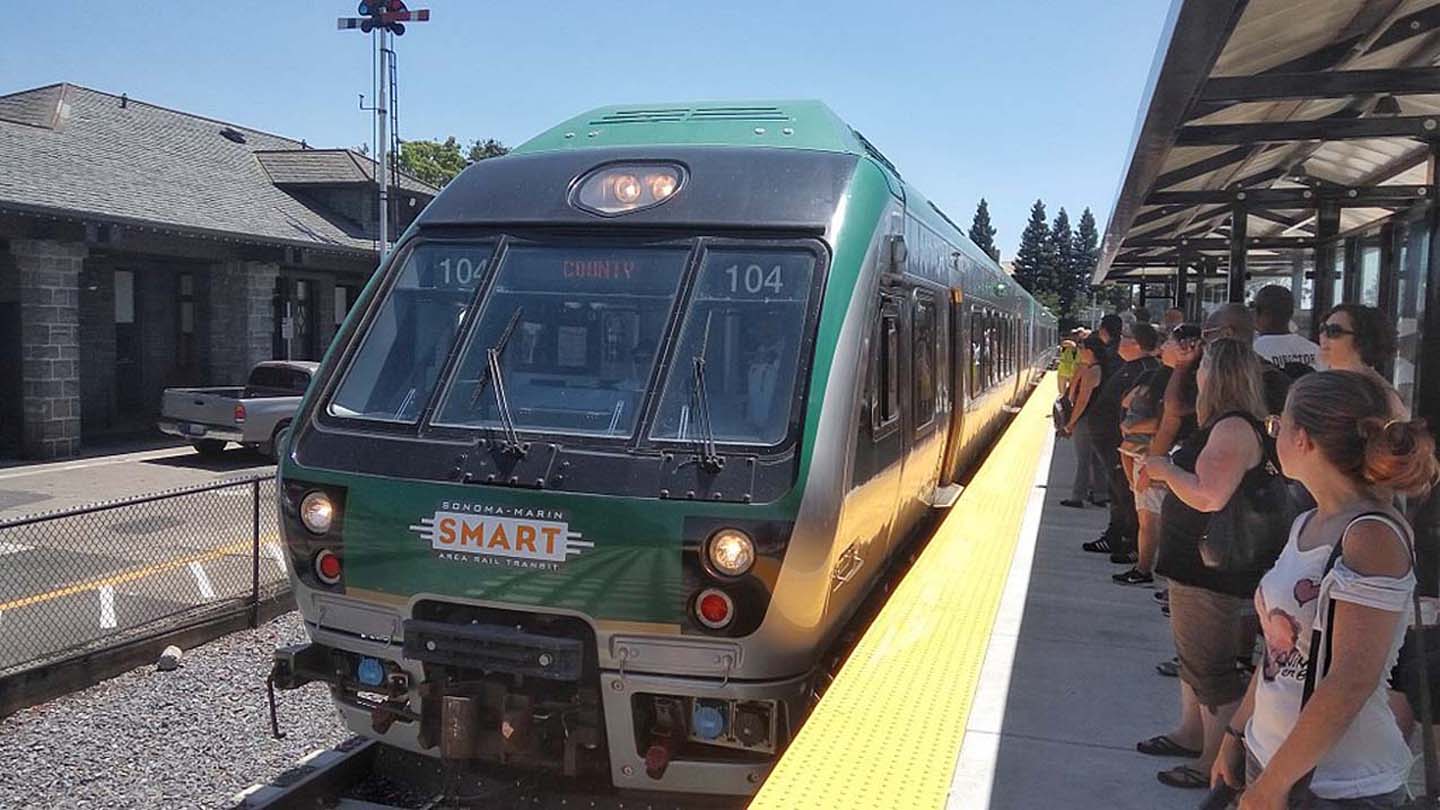By Sandy Smith, March 10, 2021

The $1.9 trillion “American Rescue Plan” … includes a $30.5-billion life preserver thrown to the nation’s public transit agencies, whose budgets have been blown to bits in the wake of steep ridership losses due to the Covid-19 pandemic.
Transit agencies across the nation are giving thanks for the infusion of money, which will help them maintain service levels and facilities for getting essential workers to and from work. But the relief won’t last forever, and ridership is likely to recover slowly at best. That’s now leading some agencies to examine other ways of raising the money they will need to survive. For some agencies blessed with large landholdings around transit stations, that means getting into the real estate development business themselves.
Meanwhile, even though the pandemic also caused vehicle miles traveled to fall, the fall hasn’t been quite as steep, and as the nation climbs out of the pandemic hole, it’s quite likely that some of those former transit riders will take to the roads instead out of concern for their own safety on board. …
And ordinary pedestrians in Pennsylvania and a handful of other states may also want to venture onto city streets and sidewalks with extra caution going forward, now that those states are approving legislation granting robot delivery vehicles the same legal rights as pedestrians.
Transit agencies welcome $30.5 billion Covid-19 lifeline …
… Railway Age reports that one of the revisions will funnel more money to transit systems nationwide than the original version had called for. According to the article, the original plan President Biden announced on Jan. 17 included $20 billion to “protect the future of transit,” and the original House budget reconciliation bill included $10 billion more than that. The bill reported out of the Senate added another $500 million to that figure.
The transit industry’s reaction to the news has been uniformly positive. The Railway Age article quoted American Public Transportation Association (APTA) President and CEO Paul P. Skoutelas as saying in a post-passage statement, “We greatly appreciate that the bill includes $30.5 billion of emergency transit funding and distributes these funds in a manner that ensures that all public transit agencies can continue to be a lifeline for our essential workers.” WPIX in New York reports that Patrick Foye, head of the Metropolitan Transportation Authority in New York, called the bill’s passage “a great day for all Americans, mass transit customers, and our heroic employees.”
The bill that cleared the Senate gives urban systems $26.09 billion to support their operations, the same amount as in the original House bill. Combined with the two prior rounds of COVID relief, urban mass transit agencies will receive 132 percent of their 2018 operating costs.
Rural systems will get $317 million, up $36 million from what the House bill authorized. This amount will cover anywhere from 5 to 20 percent of their 2018 operating costs according to a sliding-scale formula.
Services for seniors and people with disabilities will get $50 million, and $2.21 billion will help cover personnel and operating costs of subcontractors directly attributable to the pandemic. Both of these amounts are unchanged from the House version.
Finally, the bill will fund capital investments to the tune of $1.675 billion, up $425 million from the amount in the House version.
… While searching for new revenue sources themselves
Even though the American Rescue Plan has produced hosannas in transit-agency boardrooms nationwide, many of those same agencies also realize that the assistance remains a Band-Aid on a rather large wound. A number of transit agencies are thus also searching for ways to generate more revenue to support their operations as the country emerges from under the pandemic’s shadow but public transit riders do not.
Fast Company reports that several large transit agencies are finding low-hanging fruit in the land they already own around their transit stations. A good portion of that land now has parking spaces on it — lots built on the assumption that drivers would leave their cars in the lots and take the train to their final destinations. …
[A]ccording to Jessie O’Malley Solis, transit-oriented development manager for San Jose’s Valley Transportation Authority, “In the ’80s, our transit agency built seas of parking, and the theory was if you build it they will come, meaning they’ll park here and ride. That’s not how it worked in our area,” she told Fast Company. “Just building seas of parking wasn’t going to generate ridership. You needed to generate connectivity along the system to make it valuable for riders. That’s been a missing element.”
The VTA is now betting that residents will provide that connectivity. The agency, which owns about 140 acres of land around its stations, has identified 25 sites in the most densely built parts of the valley that it wants to turn into apartments, offices, and shops. When fully built out, the sites would add about 7,000 housing units, 2,500 of them affordable, and several million square feet of office and commercial space to Silicon Valley’s tight real estate market. According to the article, the developments will produce $250 million in initial revenue for the VTA, plus ongoing revenue from the ground rents the developers of the projects will pay to the agency, which will continue to own the land beneath them.
The article also notes that the Metropolitan Atlanta Rapid Transit Authority (MARTA) has similar designs on some of the 400 acres of land it owns, including both park-and-ride lots and air rights over rapid transit stations. It has 18 development projects now underway, with affordable housing mandated at seven of the sites. Two of the projects are already under construction, joining several developments MARTA has already facilitated.
Done right, such projects can go a long way towards filling empty seats on trains and doing so more effectively than park-and-ride lots do. The article notes that studies have found that transit-oriented development projects have caused ridership to rise by 20 to 40 percent at individual stations, and one study in California found that when people moved to within a half-mile of a transit station, half of them switched from driving to taking transit for their commutes.
Moreover, transit-oriented developments based on 99-year ground leases ensure steady streams of revenue for the landowning agencies. …
States say delivery robots are people, too
One of the features of our legal system that allows our economy to function is the legal fiction that a corporation is a person. Now a parallel legal fiction bids to make just walking down the street trickier at best for city-dwellers in at least five states.
Axios reports that Florida, Idaho, Pennsylvania, Virginia, and Wisconsin have all passed laws giving autonomous delivery robots free or nearly free access to sidewalks. Pennsylvania’s law goes one step further, classing the robots, which look like picnic coolers on wheels, as “pedestrians.” Said “pedestrians” can weigh as much as 550 pounds and travel down the sidewalk at speeds as high as 12 mph.
So far, 10 states and the District of Columbia have passed laws permitting the delivery bots to operate. Robot backers and developers, including Amazon and FedEx, say the vehicles hold the promise of faster deliveries and reduced congestion and emissions from idling delivery vans parked on streets. But pedestrian advocates and the National Association of City Transportation Officials (NACTO) consider these laws spectacularly misguided; NACTO says the robots “should be severely restricted if not banned outright.”
According to a Pittsburgh CityPaper article on Pennsylvania’s law, which took effect last December, labor unions like the Teamsters also oppose such legislation, for reasons that need no explanation. That article also notes that most of the laws passed to date governing the operation of delivery bots class them as pedestrians as well, but Pennsylvania’s is unusually generous in its weight and speed restrictions.
 Next City contributor Sandy Smith is the home and real estate editor at Philadelphia magazine. Over the years, his work has appeared in Hidden City Philadelphia, the Philadelphia Inquirer, and other local and regional publications. His interest in cities stretches back to his youth in Kansas City, and his career in journalism and media relations extends back that far as well.
Next City contributor Sandy Smith is the home and real estate editor at Philadelphia magazine. Over the years, his work has appeared in Hidden City Philadelphia, the Philadelphia Inquirer, and other local and regional publications. His interest in cities stretches back to his youth in Kansas City, and his career in journalism and media relations extends back that far as well.
Read the full article here. (9 min.)

